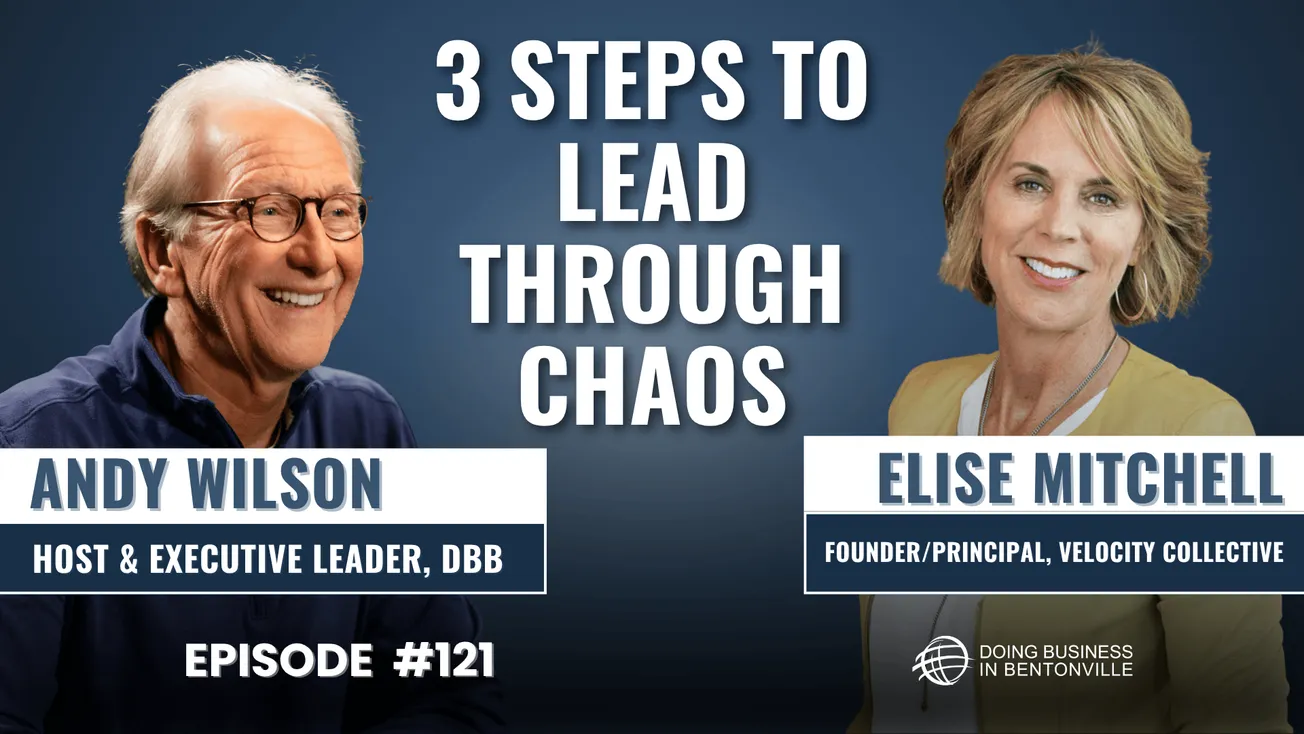Change doesn’t just test a strategy; it tests a leader. With Elise Mitchell in the chair, we go straight at the hard stuff: why your brain fights change, how to flip from threat to opportunity, and the exact conversations that pull a team out of frustration and into forward motion. Elise brings a rare mix of neuroscience, hard-won CEO lessons, and clear frameworks you can use today, including the five questions that reset a stuck team and three core principles for leading through uncertainty: embrace reality, be decisive, and connect the dots.
We unpack how to recognize an away mindset, quiet the amygdala, and fuel the prefrontal cortex so you can think clearly when the stakes rise. From there, Elise shows how to make courageous decisions without perfect information, cooling emotions, widening inputs, and sharpening discernment to balance risk and reward. Her story about selling her firm grounds the theory in real trade-offs leaders face with their people, clients, and communities on the line.
Communication becomes the force multiplier. We explore the cascade of messaging, from inner circle to broader team to clients, and a simple three-step frame to create context, connect individual roles, and cultivate confidence without pretending certainty. The throughline is trust: you’ll only lead people as far as they trust you. Earn it by telling the truth, inviting participation, and showing your work. We close with a teaser for part two: removing roadblocks, including the uncomfortable moment when the leader realizes they are the bottleneck.
If this sparked a new way to lead through change, follow the show, share it with a leader who needs it, and leave a quick review so others can find it. What’s the one decision you’re ready to “break glass, pull handle” on this week?
More About this Episode
Leading Through Change: How Great Leaders Adapt, Inspire, and Drive Transformation
Change is not just a part of doing business - it is the business. Every organization that wants to stay relevant, resilient, and competitive must master the art of navigating change. But long before a company or a team can transform, its leaders must first do the hard work of transforming themselves.
In today’s business climate - one filled with rapid disruption, global uncertainty, and shifting employee expectations - how we lead through change is more critical than ever. It's not simply about having a strategy. It’s about having the right mindset, the ability to be decisive amid uncertainty, and most importantly, the courage to look in the mirror and lead from within.
I recently had the privilege of diving into this very topic with Elise Mitchell, a seasoned CEO, award-winning entrepreneur, and executive coach who has not only built and sold a highly successful company but also dedicates her life to helping other leaders grow and lead through change.
Drawing from neuroscience, her own entrepreneurial journey, and decades of leadership experience, Elise shared a powerful framework that equips leaders with practical, actionable principles to lead themselves - and their teams - through even the most complex transitions.
Let’s unpack the core insights from that conversation and explore how you can apply them to your own leadership journey.
The Foundation of Change Begins in the Mind
Before we can talk about leading a company through transformation, we have to talk about leading ourselves. As Elise emphasized, every meaningful change starts within. Neuroscience backs this up.
When we encounter change - especially the unexpected or unwelcome kind - our brains enter what’s known as threat mode. The limbic system, which governs our fight-or-flight responses, becomes activated. In this state, our prefrontal cortex - the area responsible for strategic thinking and decision-making - goes offline.
This biological response makes it extremely difficult to process new information, remain creative, or lead with clarity. Instead, we become reactive, defensive, and closed off. Sound familiar?
To lead well through change, leaders must recognize this internal pattern and make an intentional shift from an away mindset (fueled by fear and resistance) to a toward mindset (fueled by openness and opportunity).
This is where personal responsibility becomes non-negotiable. Leadership isn’t about assigning change to others; it’s about owning it ourselves first.
The First Step: Embrace Reality
Principle 1: Accept What’s So, To Move to What’s Next
One of the most transformative moments Elise described came during a post-acquisition period when nothing was going according to plan. Frustrated, stuck, and emotionally drained, she gathered her leadership team for a brutally honest meeting.
They worked through five critical questions:
- What is our current reality?
- What can’t we control?
- What can we control?
- What do we want to achieve now?
- How does our strategy need to change?
This wasn’t just an exercise in brainstorming - it was an intentional effort to shift their collective mindset from problem-focused to solution-focused. By accepting the truth of their circumstances, they could finally move forward with clarity and purpose.
As leaders, this kind of honesty - both with ourselves and with our teams - is essential. It’s the groundwork for building trust. And without trust, you simply cannot lead others through transformation.
You can only lead your team as far as they trust you.
Be Decisive: Break the Glass and Pull the Handle
Principle 2: Be Decisive, Even When It’s Hard
In a crisis, the natural tendency is to hesitate. We wait for more information, for greater clarity, for permission. But effective leaders understand that inaction is also a decision - and often a damaging one.
Elise calls this moment the “break glass, pull handle” stage. The fire alarm is going off. It’s time to act.
But decisive leadership doesn’t mean rushing blindly. It means making informed choices with the best available data, and doing so courageously - sometimes with more courage than confidence.
When Elise faced one of the biggest decisions of her career - whether or not to sell her company - she wrestled with doubt, fear, and conflicting advice. But through disciplined thinking and listening to diverse perspectives, she learned to:
- Set emotions aside and focus on facts
- Embrace the value of multiple viewpoints
- Discern between short-term discomfort and long-term opportunity
- Avoid decision-making biases (especially confirmation bias)
Great leaders don’t wait for perfect clarity. They make the call, own the outcome, and keep moving forward.
Bring the Team With You
Principle 3: Connect the Dots
Once a leader has clarity, the next step is ensuring the team sees what they see. This is where many leaders fail - not out of malice, but because they forget that their team isn’t privy to the same conversations, context, or internal processing.
Effective communication is about more than delivering a polished message. It’s about framing the story in a way that helps others find their place in it.
Elise offered a simple, powerful 3-part structure to help leaders frame change communication effectively:
- Create context: Explain what’s happening, why it’s happening, and how you got to this point.
- Connect the dots: Help each team member see how the change impacts them - and how their contributions matter moving forward.
- Cultivate confidence: Acknowledge uncertainty, but affirm your belief that together, you can figure it out.
This last piece - confidence - is critical. Even if you don’t have all the answers, your people want to know that you believe in their ability to navigate the unknown.
And don’t forget: bringing the team along isn’t just about talking at them. It’s about involving them—inviting their ideas, input, and concerns into the process. This co-creation builds deeper ownership and strengthens trust.
Change Starts With You
Throughout our conversation, one theme stood out again and again: Change is personal before it’s professional.
It’s not just about shifting systems, updating strategy decks, or launching new initiatives. It’s about shifting mindsets - first your own, then your team's.
You might be the CEO, the VP, or a rising leader. No matter your title, you will never lead others well through change if you haven’t first led yourself.
This is a leadership discipline that requires:
- Emotional intelligence
- Humility
- Resilience
- A willingness to listen
- And the courage to act
And it’s not a one-time decision. It’s a continuous practice.
What’s Next: Removing Roadblocks
We’re only halfway through Elise’s 7 Principles for Leading Through Change. In Part 2 of our conversation, we’ll tackle the next four principles, beginning with removing roadblocks—and the powerful (and surprising) story Elise shares about realizing she had become the roadblock to her own team’s success.
We’ll talk about:
- How to identify hidden obstacles in your organization (or yourself)
- Why building a culture of psychological safety is non-negotiable
- How to build momentum during uncertainty
- And how to sustain trust and performance through long-term change
If you’re facing change in your organization - or wrestling with it personally - these insights will equip you with practical tools to lead forward with clarity, confidence, and integrity.
Because in the end, leadership isn’t about always getting it right. It’s about being real, being decisive, and building trust that endures - even when everything else is shifting.
Stay tuned for Part 2.










